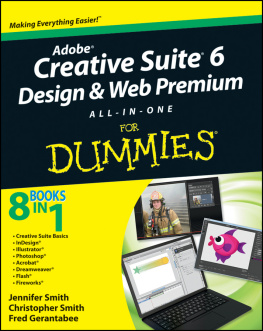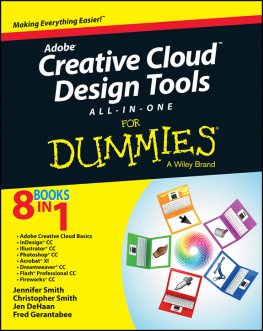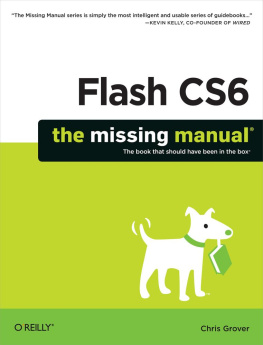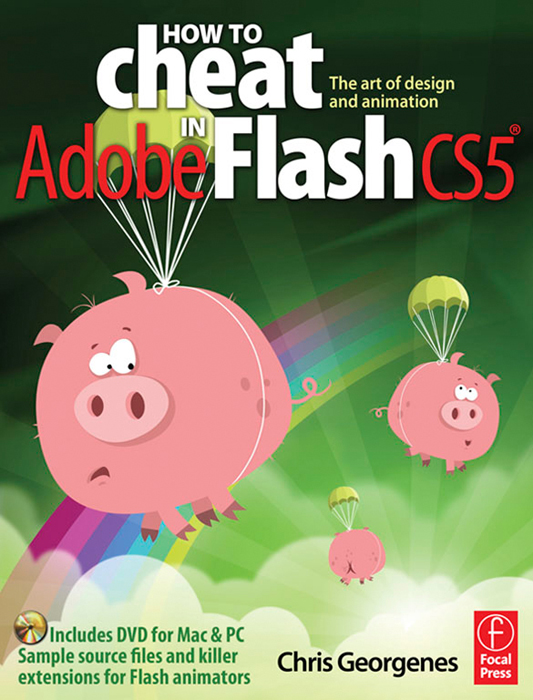HOW TO
cheat
IN
Adobe Flash CS5
The art of design and animation
Chris Georgenes

Focal Press is an imprint of Elsevier
The Boulevard, Langford Lane, Kidlington, Oxford, OX5 1GB, UK
30 Corporate Drive, Suite 400, Burlington, MA 01803, USA
First published 2010
Copyright 2010 Chris Georgenes. Elsevier Ltd. All rights reserved.
The right of Chris Georgenes to be identified as the author of this work has been asserted in accordance with the Copyright, Designs and Patents Act 1988
No part of this publication may be reproduced or transmitted in any form or by any means, electronic or mechanical, including photocopying, recording, or any information storage and retrieval system, without permission in writing from the publisher. Details on how to seek permission, further information about the Publisher's permissions policies and our arrangement with organizations such as the Copyright Clearance Center and the Copyright Licensing Agency, can be found at our website: www.elsevier.com/permissions
This book and the individual contributions contained in it are protected under copyright by the Publisher (other than as may be noted herein).
Notices
Knowledge and best practice in this field are constantly changing. As new research and experience broaden our understanding, changes in research methods, professional practices, or medical treatment may become necessary.
Practitioners and researchers must always rely on their own experience and knowledge in evaluating and using any information, methods, compounds, or experiments described herein. In using such information or methods they should be mindful of their own safety and the safety of others, including parties for whom they have a professional responsibility.
To the fullest extent of the law, neither the Publisher nor the authors, contributors, or editors, assume any liability for any injury and/or damage to persons or property as a matter of products liability, negligence or otherwise, or from any use or operation of any methods, products, instructions, or ideas contained in the material herein.
British Library Cataloguing in Publication Data
A catalogue record for this book is available from the British Library
Library of Congress Control Number: 2010930291
ISBN: 978-0-240-52207-4
For information on all Focal Press publications visit our website at www.focalpress.com

Foreword
Over ten years ago in a dimly lit basement, I started using the Flash authoring tool to create unpalatable, short, frame-by-frame animations - and discovered it was much easier than other tools I had been using to do the same thing. It's hard to believe what Flash has become over the years, and how many more people are out there using it to create content and share their work. One of the nice and inspiring things about Flash is that it attracts so many different users, from creative animators to hard-core programmers, and all sorts of people in-between.
I was assigned to work on testing a new type of motion tween for Flash a few years ago. Because the feature was already developed (but at the time untested), I needed to learn how everything worked from the ground up. Similar to other migrating Flash users, I have experienced and understand the learning curve between new and classic motion tweens! The new motion tweens are a different way of thinking about animation in Flash, however they do offer many advantages such as fewer broken tweens, attached motion paths, independent tweenable properties, tween presets, and preset eases. Some animations I've created in the past were faster or easier to accomplish after a bit of time spent with the new model. What about using classic motion tweens? Yes, there are some workflows where classic tweens are necessary and a couple cases where they're faster to use. However, the goal is to enhance and improve new motion tweens and the Motion Editor so using them is always possible and preferred.
You certainly don't need to learn everything there is to know about Flash and ActionScript to master the tool - you can choose to focus your talents on design or development, or challenge yourself from time to time by crossing over between graphics and code. But now that Flash is full of features and capable of so much, the tools can seem rather daunting to learn. But if you have helpful resources at your side, like this book, learning Flash doesn't need to be difficult. I believe the key to learning Flash is to keep it simple when you start out, take it slow, use the available resources (like books), and try to be patient. Also don't be afraid to go online and ask for help, we've all been there! Learning Flash takes some time, but it is a lot of fun and very rewarding.
Flash is an incredible tool for expressing your creativity, style, and unique ideas. Whether you're a new or existing Flash user, now is a great time to learn or use the software and get involved with the Flash community online. I hope that you use Flash with this book to get inspired, learn valuable new tricks and techniques, and create some wonderful animation. And of course, make sure to have fun with the software while you read and learn all about how to animate!
Jen deHaan
Sr. Software Quality Engineer, Flash Authoring
Adobe Systems Inc.
How to cheat, and why
The truth about cheating
The word cheat, in most cases, has a negative connotation. To cheat implies deception and trickery associated with a fraudulent act. In some ways this book will show you how you can trick your audience, not unlike a magician's sleight of hand technique where you can control not only what is being seen, but how the viewer sees it. But this book will certainly not teach you how to be a fraud.
To cheat in Flash is to find shortcuts to help you work more efficiently and economically. Time translates to money and if you can deliver a great looking project on time, that means you stayed within budget and everybody wins.
My philosophy
At the end of the day, if I didn't have any fun, then it would be time to find another job. But I had to learn this lesson the hard way a few years ago while working with an animation company designing a network television series. I was designing the main characters for a show called Science Court (ABC), and there was a conflict between us and the network as to the choice of skin color for one of the characters.
I liked green and the network preferred orange. I felt strongly that my color choice was the best and I admit I may have let myself become emotionally charged about the issue. One day I went to lunch with the animation director and we were casually talking about the color issue. It was something he said that changed my outlook on work from that day forward: We must have pretty cool jobs when the most stressful part of our day is whether or not a character looks too much like a frog.
I stopped dead in my tracks, instantly realizing how right he was and how silly I felt about the matter. After lunch we returned to the studio where I immediately changed the character to orange and never uttered another word about it. I even ended up liking the orange more than the green. Since then, my philosophy has always been to have fun no matter how stressful my workday gets. My job, in comparison to all other possible occupations, is the best job even on the worst of days.









